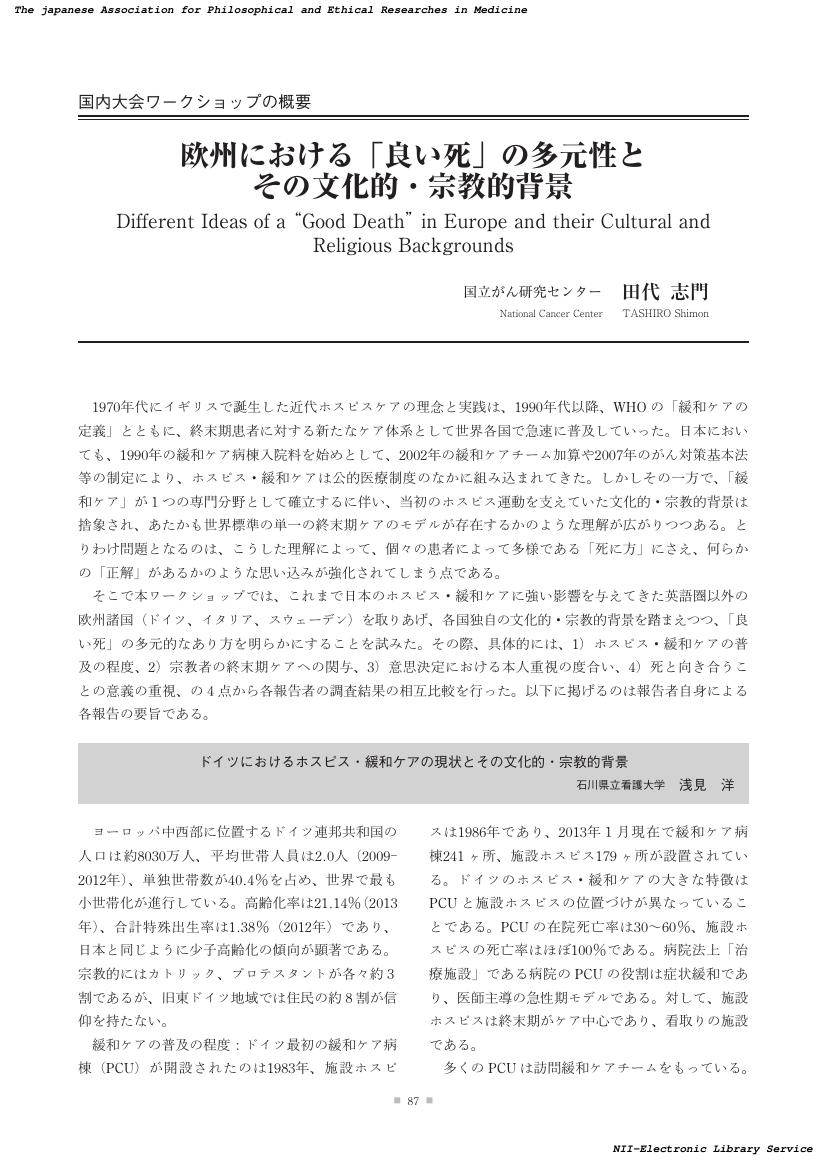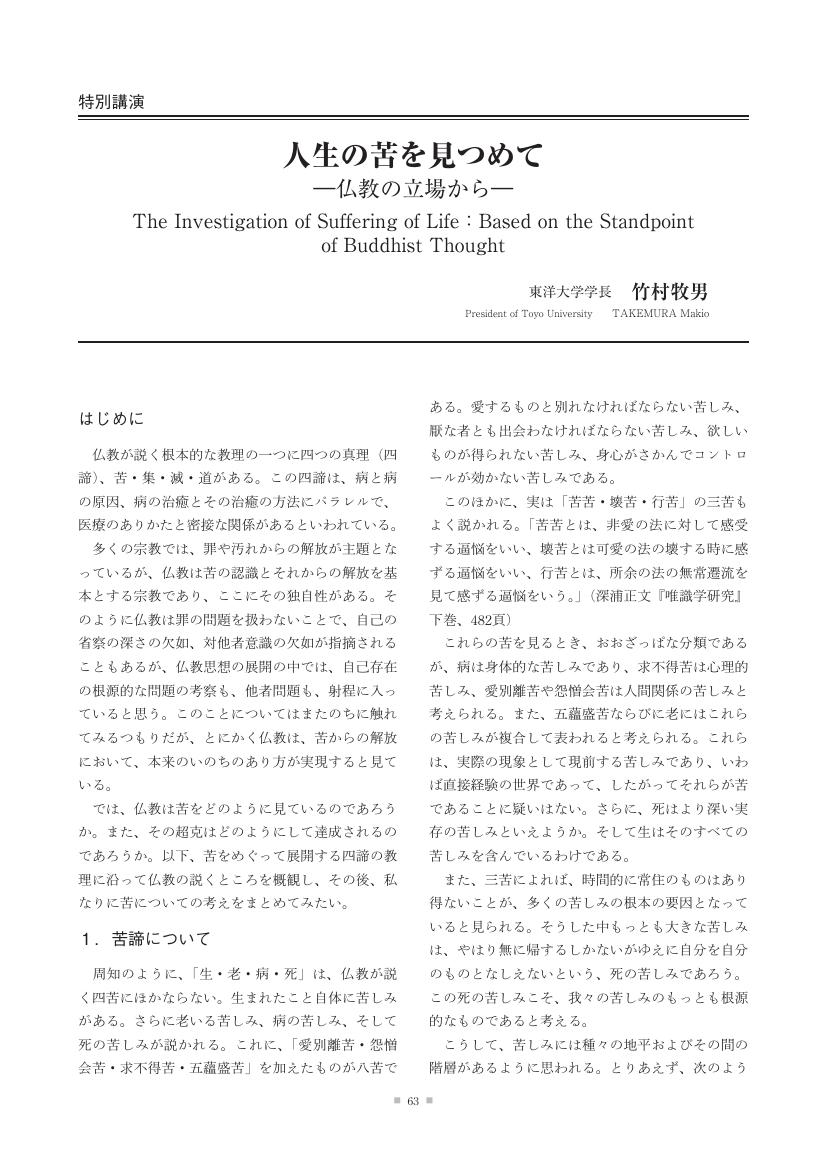1 0 0 0 OA 第33回国内大会及び第1回国際大会の概要(東洋大大会について)
- 著者
- 長島 隆
- 出版者
- 日本医学哲学・倫理学会
- 雑誌
- 医学哲学 医学倫理 (ISSN:02896427)
- 巻号頁・発行日
- vol.33, pp.59, 2015-09-30 (Released:2018-02-01)
1 0 0 0 OA 多文化社会における医療倫理(国際大会 基調講演)
- 著者
- 小出 泰士
- 出版者
- 日本医学哲学・倫理学会
- 雑誌
- 医学哲学 医学倫理 (ISSN:02896427)
- 巻号頁・発行日
- vol.33, pp.60-65, 2015-09-30 (Released:2018-02-01)
1 0 0 0 OA グローバル時代における地域医療と医療倫理 : 3.11以後の時代に(国際大会 基調講演)
- 著者
- 長島 隆
- 出版者
- 日本医学哲学・倫理学会
- 雑誌
- 医学哲学 医学倫理 (ISSN:02896427)
- 巻号頁・発行日
- vol.33, pp.66-73, 2015-09-30 (Released:2018-02-01)
- 著者
- ハイネマン トーマス 松田 純
- 出版者
- 日本医学哲学・倫理学会
- 雑誌
- 医学哲学 医学倫理 (ISSN:02896427)
- 巻号頁・発行日
- vol.33, pp.74-81, 2015-09-30 (Released:2018-02-01)
1 0 0 0 OA オランダにおける医師と終末期(国際大会シンポジウムの概要)
- 著者
- ファン・デルデン J.J.M. 小沼 有理子
- 出版者
- 日本医学哲学・倫理学会
- 雑誌
- 医学哲学 医学倫理 (ISSN:02896427)
- 巻号頁・発行日
- vol.33, pp.82-86, 2015-09-30 (Released:2018-02-01)
1 0 0 0 OA 欧州における「良い死」の多元性とその文化的・宗教的背景(国内大会ワークショップの概要)
- 著者
- 田代 志門
- 出版者
- 日本医学哲学・倫理学会
- 雑誌
- 医学哲学 医学倫理 (ISSN:02896427)
- 巻号頁・発行日
- vol.33, pp.87, 2015-09-30 (Released:2018-02-01)
1 0 0 0 OA 「商品」としての腎臓 フィリピンにおける生体腎移植の民族誌
- 著者
- 島薗 洋介
- 出版者
- 日本医学哲学・倫理学会
- 雑誌
- 医学哲学 医学倫理 (ISSN:02896427)
- 巻号頁・発行日
- vol.32, pp.83-89, 2014 (Released:2018-02-01)
1 0 0 0 OA 生殖技術のグローバル化と日本
- 著者
- 日比野 由利
- 出版者
- 日本医学哲学・倫理学会
- 雑誌
- 医学哲学 医学倫理 (ISSN:02896427)
- 巻号頁・発行日
- vol.32, pp.90-95, 2014 (Released:2018-02-01)
1 0 0 0 OA 国際共同研究の倫理 研究の「利益」とグローバルな正義
- 著者
- 田代 志門
- 出版者
- 日本医学哲学・倫理学会
- 雑誌
- 医学哲学 医学倫理 (ISSN:02896427)
- 巻号頁・発行日
- vol.32, pp.96-100, 2014 (Released:2018-02-01)
1 0 0 0 OA 平山正実名誉会員のご逝去を悼む
- 出版者
- 日本医学哲学・倫理学会
- 雑誌
- 医学哲学 医学倫理 (ISSN:02896427)
- 巻号頁・発行日
- vol.32, pp.104, 2014 (Released:2018-02-01)
1 0 0 0 OA 死の法的基準としての脳死
- 著者
- 水野 俊誠
- 出版者
- 日本医学哲学・倫理学会
- 雑誌
- 医学哲学 医学倫理 (ISSN:02896427)
- 巻号頁・発行日
- vol.33, pp.21-29, 2015-09-30 (Released:2018-02-01)
Can brain-death be the criterion of human death? This paper examines critically the main views regarding this issue and proposes a new view. First, I argue that the following three major views are implausible: (1) the President's Commission's view (the whole brain formulation), (2) Shewmon's view(the circulation formulation), and (3) Lizza's view (the higher brain formulation). Second, I propose my view. Distinguishing two questions-"Can brain-death be the criterion of(human) biological death?" and "Can brain-death be the criterion of (human) legal death?", the following points are discussed: (1) With regard to the first question, given that some organs function in harmony together in brain dead patients, their somatic organization is maintained, i.e., brain dead patients are still alive. Therefore, brain-death cannot be the criterion of biological death. (2) With regard to the second question, if four-organ systems are (biologically alive but) legally dead, so are brain dead patients, and thus brain-death can serve as a criterion of legal death. On the other hand, based on the premise that four-organ systems could be considered an intermediate state between being alive and dead, brain-dead patients would also be considered being in the intermediate state; therefore, brain-death cannot serve as the criterion of legal death.
- 著者
- 南 貴子
- 出版者
- 日本医学哲学・倫理学会
- 雑誌
- 医学哲学 医学倫理 (ISSN:02896427)
- 巻号頁・発行日
- vol.32, pp.22-32, 2014 (Released:2018-02-01)
With the development of assisted reproductive technology (ART), the number of families having children through donor conception is increasing. In Japan, there is no overall legislation regulating ART, but many offspring have already been born through donor insemination. Because of the condition of donor anonymity, they do not have the right to know their origin. Overseas, the number of jurisdictions abolishing donor anonymity and allowing offspring the right to know their origin is increasing, but even in those jurisdictions, offspring born before the enforcement of legislation are not guaranteed the right to access information about their donors. By reference to the case of Victoria, Australia, this paper analyzes the issues concerning legislation on offspring’s retrospective right to know their origin. The Victorian Law Reform Committee tabled its report in March 2012 recommending that the Victorian Government retrospectively allow donor-conceived offspring to obtain identifying information about their donors. In response to this recommendation, the Victorian Government carried out a further investigation of the opinions of past donors and gave its final response in August 2013, stating that offspring would be allowed to know their donor’s identity only with the consent of their respective donors. By analyzing the responses of society, especially those of donors who had donated their gametes under the condition of anonymity, the problems underlying the introduction of legislation allowing offspring the retrospective right to know their origin are discussed from the perspective of conflict and balance among the rights of offspring, parents and donors.
1 0 0 0 OA 看護職のチーム医療における協働と自律性 歴史的背景と調査結果からの考察
- 著者
- 勝山 美貴子
- 出版者
- 日本医学哲学・倫理学会
- 雑誌
- 医学哲学 医学倫理 (ISSN:02896427)
- 巻号頁・発行日
- vol.32, pp.33-42, 2014 (Released:2018-02-01)
Today, mutual collaboration among the various fields that provide human services is being promoted as an essential challenge for implementation of these services. This is also true for the medical care field; however, collaboration and cooperation between the different types of medical jobs is not sufficient. This paper has three objectives. First, it clarifies the roles of the locations and targets that it is handling based on the typification of Interdisciplinary care. In this regard, it defines “collaboration” and “autonomy,” both of which are required for Interdisciplinary care. Second, the paper defines how the different types of jobs in nursing are collaboration to provide Interdisciplinary care. Moreover, the paper evaluates the training and management of such jobs. Then, in light of historical studies of nursing and the findings of this study, problems in nursing are analyzed and discussed from the view point of“ collaboration” and “autonomy” defined in this paper. Third, this paper discusses methods for ensuring effective and efficient collaboration and coordination, as well as the autonomy in professional medical care jobs. By achieving these objectives, this paper discusses the problems and challenges a medical team faces that is recognized in the nursing profession from the perspective of collaboration and autonomy.
1 0 0 0 OA ジェフ・マクマハンの脳説における人の同一性問題
- 著者
- 峯村 優一
- 出版者
- 日本医学哲学・倫理学会
- 雑誌
- 医学哲学 医学倫理 (ISSN:02896427)
- 巻号頁・発行日
- vol.32, pp.53-63, 2014 (Released:2018-02-01)
According to Jeff McMahan’s brain view, personal identity is preserved by the existence of a person, a conscious entity with consciousness function due to brain function. An organism which has no consciousness function or irreversibly loses it, but has only integrative function is regarded as an entity, one which is essentially different from a person who possesses consciousness function. In this article, I examine the personal identity problem of McMahan’s brain view, analyzing the issues regarding the existence of an embryo, that of a patient in a persistent vegetative state (PVS), and the relationship between the two entities, ‘a person’ and ‘a human organism’, respectively. Contrary to McMahan’s view, I first maintain that we should consider an early embryo who has no brain function yet grows as the same entity, an organism, with the acquirement of consciousness function due to brain function while changing in different phases of life, not being a different entity, a person, with that function. Second, I claim that a PVS patient who is presumed to no longer possess cerebrum function does not lose interest in living and is alive as an organism with the same identity prior to that condition. Third, I argue that McMahan’s brain view under which the two different entities, a person and a human organism, are presumed to coexist in an organism falls into‘ the too many thinkers problem’ in principle and thus, it will not become the theory which could consistently explain personal identity.
1 0 0 0 OA 触覚の発見 高次脳機能障害者の手記の解釈
- 著者
- 中野 桂子
- 出版者
- 日本医学哲学・倫理学会
- 雑誌
- 医学哲学 医学倫理 (ISSN:02896427)
- 巻号頁・発行日
- vol.32, pp.64-70, 2014 (Released:2018-02-01)
This paper aims to clarify how a higher brain dysfunction, Kikuko Yamada recovers from her visual agnosia. According to her notes, the vision damage makes many errors of judging and doing in the everyday life of her. For example, she is not able to operate the water closet, have a meal, and go down the stairs. Sometimes, someone within herself says why don’t you try touching instead of looking to her. After much difficulty, at length, she tries touching many things. Thus, Yamada escapes from the dependence on vision in the modern life centered around vision. Touch as somatic sensation is dull in comparison with vision, audition, taste, olfaction as special sensations. But touch is the base or very root of all sensations. Therefore, touch is the certain, unquestionable, and stable sensation. Then, things which I can touch are manifest to me. Yamada is taught to try touching the surrounding things in order to pass judgment, by someone within herself. Yamada named this someone Zenkochan( Frontal) of Zentouyou( Frontal lobe). Of course, Zenkochan is not the frontal lobe but personality of Yamada. So, she is another“ I,” that is personality. Thus, personality is self, and this self calls Yamada’s attention to touch.
1 0 0 0 OA 医療現場における異文化コミュニケーションの問題
- 著者
- 有馬 斉
- 出版者
- 日本医学哲学・倫理学会
- 雑誌
- 医学哲学 医学倫理 (ISSN:02896427)
- 巻号頁・発行日
- vol.32, pp.71-75, 2014 (Released:2018-02-01)
1 0 0 0 OA 現在の医療の問題点とその解決策 有機医療の提唱
- 著者
- 佐古田 三郎
- 出版者
- 日本医学哲学・倫理学会
- 雑誌
- 医学哲学 医学倫理 (ISSN:02896427)
- 巻号頁・発行日
- vol.32, pp.76-79, 2014 (Released:2018-02-01)
1 0 0 0 OA 〈シンポジウムのまとめ〉医療のグローバル化 臓器移植・生殖補助医療・臨床試験
- 著者
- 江口 聡 堀田 義太郎
- 出版者
- 日本医学哲学・倫理学会
- 雑誌
- 医学哲学 医学倫理 (ISSN:02896427)
- 巻号頁・発行日
- vol.32, pp.80-82, 2014 (Released:2018-02-01)
1 0 0 0 OA 人生の苦を見つめて 仏教の立場から
- 著者
- 竹村 牧男
- 出版者
- 日本医学哲学・倫理学会
- 雑誌
- 医学哲学 医学倫理 (ISSN:02896427)
- 巻号頁・発行日
- vol.31, pp.63-71, 2013 (Released:2018-02-01)
1 0 0 0 OA 生老病死/ライフコース 臨床において人生苦をいかに受け止めるか
- 著者
- 竹内 慶至 浅見 洋
- 出版者
- 日本医学哲学・倫理学会
- 雑誌
- 医学哲学 医学倫理 (ISSN:02896427)
- 巻号頁・発行日
- vol.31, pp.72-73, 2013 (Released:2018-02-01)














